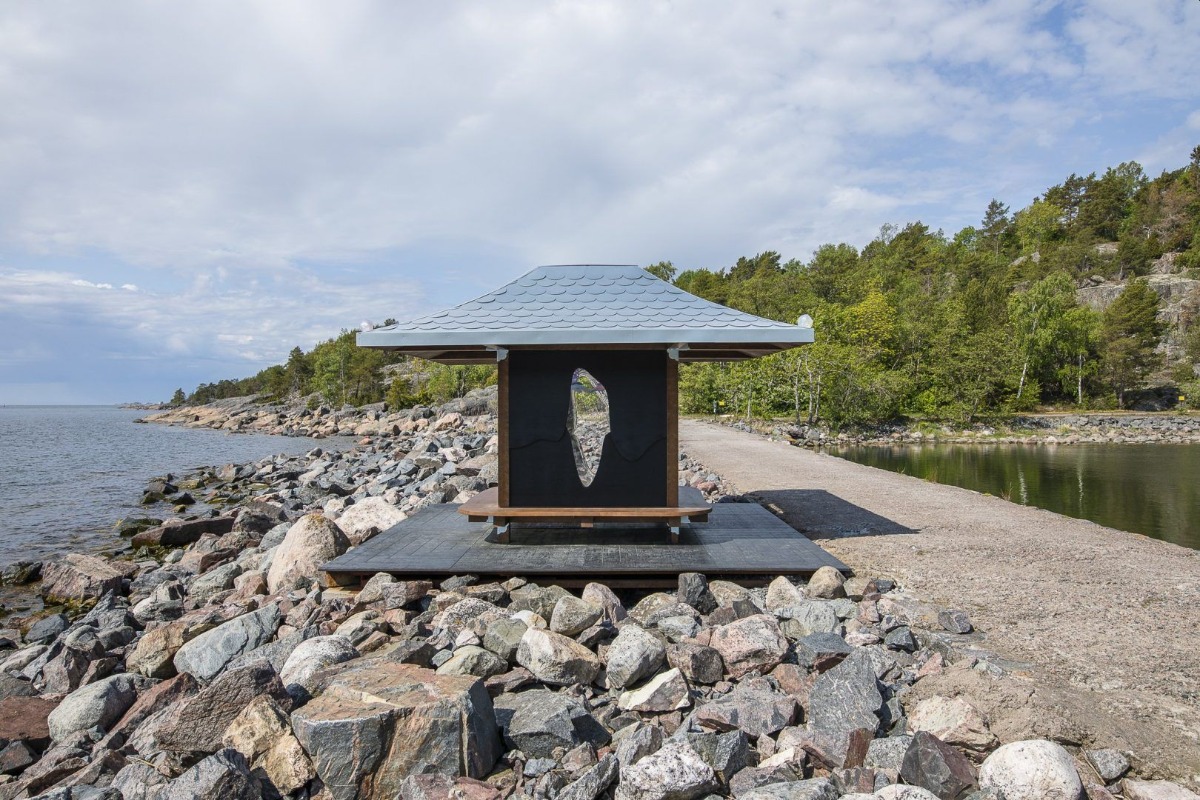
The Dominance of Nature Over Art
Alexander Burenkov
Notes on a Helsinki Biennial 2023
As the autumnal embrace settled in at the end of October, HAM Helsinki Art Museum, the driving force behind the Helsinki Biennial, unveiled its report on the 2023 biennial edition, a symphony of artistic endeavor that undeniably achieved four of its five ambitious objectives. Although it fell short of the lofty expectation of attracting 300,000 visitors, the effusive praise showered upon it by attendees and the attention it garnered from esteemed international media outlets such as Frieze, Forbes, Wallpaper, The Telegraph, and Euronews has left a positively resonant note. Now is the moment for contemplation, to delve into the essence of this biennial and ponder its peculiarities.
For the second consecutive time, the epicenter of the biennial extravaganza was the secluded island of Vallisaari, a serene oasis nestled near the historic Sveaborg fortress in Helsinki, a mere 20-minute ferry ride from the bustling heart of the city, the Market Square. This archaic haven, steeped in Finnish-Russian heritage, reverberates with echoes of its former glory, affectionately known as Aleksandrovsky in homage to Emperor Alexander II. Here, a rich tapestry of history unfolds, where centuries-old fortifications, military barracks, formidable artillery batteries, and a well-preserved powder magazine stand as silent sentinels to bygone eras. In the 20th century, this island sanctuary belonged to the Finnish Defense Forces, shielded from public gaze, only to be graciously unveiled to eco-tourists a mere six years ago. Through the passage of time, Vallisaari has nurtured rare botanical species, sustaining a haven for a multitude of fauna and flora. Delicate forbs, luxuriant shrubbery, and an opulent profusion of mosses, ferns and lichens, their grace evident on the undulating terrain and rocky promontories, leave one in awe, challenging the belief that this natural masterpiece is anything less than the meticulous handiwork of skilled landscape architects.
Emilija Skarnulyte, Hypoxia, 2023, Helsinki Biennial 12.6.-17.9.2023, Vallisaari, Helsinki, Photo: © HAM/Helsinki Biennial/Kirsi Halkola
In contrast, the subtle, almost ethereal art selected for this year’s exhibition by curator Joasia Krysa chose to elude spectators. Concealed amongst the verdant tapestry and overshadowed by the omnipresent trees and shrubs, it fell short in comparison to the enchanting landscapes when it came to offering entertainment value. In 2021, the Helsinki Biennial showcased the artistic brilliance of 41 talents, but the current edition comprised a more modest list of 24 participating artists. Regrettably, not all of them were destined to be uncovered by the curious visitors. Dubbed “New Directions May Emerge”, this edition deliberately featured a reduced number of artists and artworks, strategically orchestrated by Joasia Krysa to provide an intimate space for introspection and facilitate a nuanced dialogue with the surroundings. This curatorial decision, drenched in poetic intent, was inspired by a quote from the eminent anthropologist Anna Lowenhaupt Tsing, encouraging the art of “noticing”. It prompted viewers to engage their sensory faculties, urging them to scrutinize the manifold facets of existence, from fellow humans and animals to the lush flora, the environment, data streams, and other entities that coexist with us. It served as a conduit to envision fresh perspectives on cohabitation with, and comprehension of, the world at large. But before embarking on this quest for alternative paradigms of existence in this world, visitors encountered the formidable challenge of unearthing art installations hidden amid the forest backdrop and urban milieu.
Adrián Villar Rojas: From the Series The End of Imagination, 2023. © HAM/Helsinki Biennial/Viljami Annanolli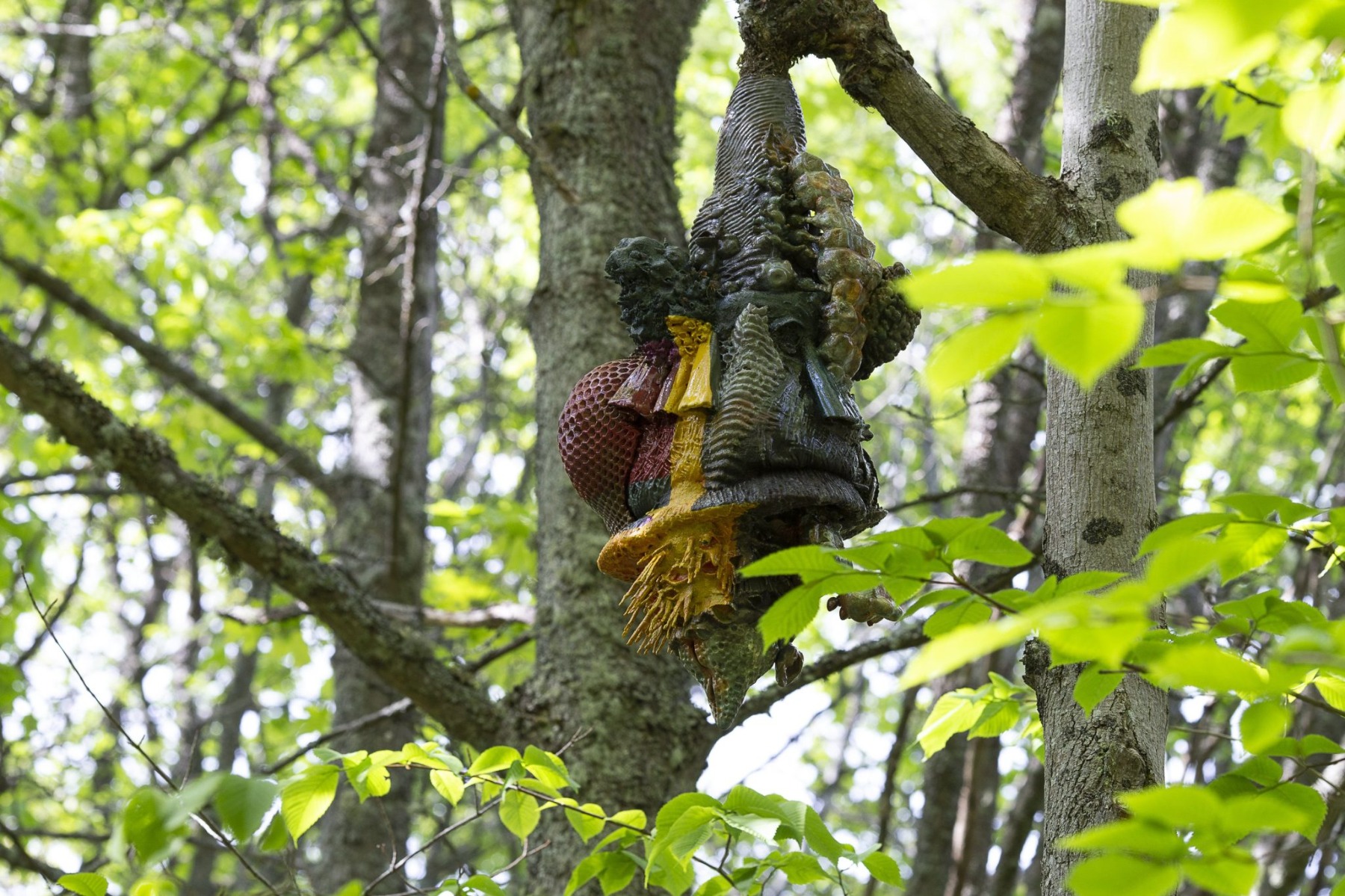
Adrián Villar Rojas embarked on the creation of a site-specific series comprising 15 sculptures conceived to converse with the island’s surroundings and its denizens. Inspired by the Argentinian hornero bird, famed for crafting its nests from a melange of mud, straw and debris, Rojas ingeniously adapting his “nests” to a world heavily influenced by human construction. Here, these nests transcended the organic realm, emerging as constructs of non-organic and artificial materials representing the human domain. The endeavor of discovering these sculptures, randomly affixed to various trees across the island, evolved into an engaging yet arduous quest akin to the digital pursuit of Pokémon Go, albeit without the allure of rewards for the diligent. The series bore a visionary title, “The End of Imagination”, challenging visitors to stretch the boundaries of their creative faculties by urging them to conjure mental images of sculptures that, despite their earnest and determined searches, eluded their physical grasp within the forest. A more apt title for the series might have been “The End of Patience”.
Within the tapestry of bewilderment and dissonance that permeated the Helsinki Biennial 2023, there emerged an art project that defied convention and invoked a sense of inquisitive unease. “Thou Shall Not Assume”, a creation by the London-based Danielle Brathwaite-Shirley, transcended expectations. The narrative of Black Trans individuals, so distant from the typical discourse of an abandoned island nestled north of the Gulf of Finland, found a peculiar resonance in this unique setting. Brathwaite-Shirley beckoned visitors to partake in a role-playing performance, a carefully choreographed event and installation that transported participants through a labyrinthine journey acquainting them with an ensemble of characters and scenarios that steered their collaborative decision-making. These characters, manifesting as tangible sculptures on the island, were the physical embodiment of a more expansive digital pilgrimage accessible through a dedicated website. The digital narratives, replete with rich backstories, revealed themselves as a more immersive experience than their corporeal counterparts. Ravaged by the ceaseless island rains, the sculptures assumed the timeworn visage of ancient scarecrows, their forms contorted by the elements. This predicament encapsulated a recurring theme of the biennial, where physical discoveries often paled in comparison to their digital avatars. One couldn’t help but ponder the prospect of transforming the entire biennial into an online spectacle, an intriguing proposition indeed.
Keiken, Ángel Yōkai Atā, 2023, Helsinki Biennial 12.6.-17.9.2023, Vallisaari, Helsinki, Photo: © HAM/Helsinki Biennial/Sonja Hyytiäinen
Nonetheless, certain projects, ensconced amidst the island’s idyllic landscape, offered a profound spatial experience that defied the prevailing dissonance. Alma Heikkilä’s “coadapted with” embodied this paradigm, comprising a sculpture ensconced within canvases that framed a space-within-a-space within the forest. Here, an ecosystem unfolded, a symbiotic interplay between rainwater and plant dyes derived from indigenous flora that dripped onto the sculpture, imbuing it with evolving hues over the summer months. Another gem of the biennial was Lotta Petronella’s “Materia Medica of Islands”. An apothecary of sorts, it housed an installation brimming with medicinal plants and recipes, offering a nurturing concoction of resistance. Collaborating with Sami Tallberg, a luminary chef, food writer, and foraging pioneer, as well as Lau Nau, the composer and performer, the work delved into the practice of lamentation, a ritual of collective healing that found its voice through the narratives of women. Remarkably, the Keiken collective, renowned for its creation of speculative realms through cutting-edge gaming, Extended Reality (XR), blockchain, and performance, made an intriguing foray into the realm of physical reality with “Ángel Yōkai Atā”. This art piece serves as a portal granting access to a speculative world that exists beyond the boundaries of immediate experience. The inspiration for this endeavor stemmed from a visit to a mystical spirit house in Thailand. The portal unfolds into three distinct encounters. Firstly, there is a captivating sound work that engages the senses. Secondly, a physical house nestled on the isthmus connecting the Vallisaari and Kuninkaansaari islands has been crafted as a dwelling for angels and spirits. Finally, the narrative extends to an online interactive game known as “Angel Arcade”; set against a backdrop in the distant future, approximately a millennium from our present time, this is the most astonishing part. In this future, humanity, now referred to as “Angels”, has harnessed post-human capabilities through the organic re-engineering of their cells. This transformation empowers them to access non-human consciousness and intermingle with various species. Notably, the interactive game “Angel Arcade” invites participation from anyone interested, and it does not necessitate a visit to Vallisaari or the gallery space at the Cultural Centre Stoa.
Yet, the true revelation unfolded beneath the ancient arches of former military warehouses and gunpowder magazines where visitors sought refuge from the relentless rain, often lingering for extended intervals. Here, they encountered the meditative opus “Oikos” by Matti Aikio, a Sámi artist rooted in the heritage of reindeer herding. Aikio’s work, a testament to his cultural background and lived experiences, explored the juxtaposition of modern Western society with indigenous cultures. It delved into the complexities of their respective worldviews, notions of space and time, and the multifaceted tapestry of human relationships with the natural world. Another entrancing video work was “Hypoxia” by Emilija Škarnulytė, a dreamy composition interweaving documentary footage of the Baltic Sea during the 2022 Nord Stream gas leak with mesmerizing shots of the sea floor strewn with remnants of discarded ammunition seeping chemicals into the depths. Škarnulytė’s visual tapestry seamlessly melded with the myth of Jūratė, a Lithuanian mermaid whose tears for her slain beloved crystallize as amber on the shores of the Baltic. This union of science fiction and folklore wove a spellbinding narrative, not merely enchanting the observer but proffering a wellspring of potential solutions to our contemporary technological dilemmas and forging new vistas toward alternative trajectories of development.
Alma Heikkilä: coadapted with, 2023. © HAM/Helsinki Biennial/Kirsi Halkola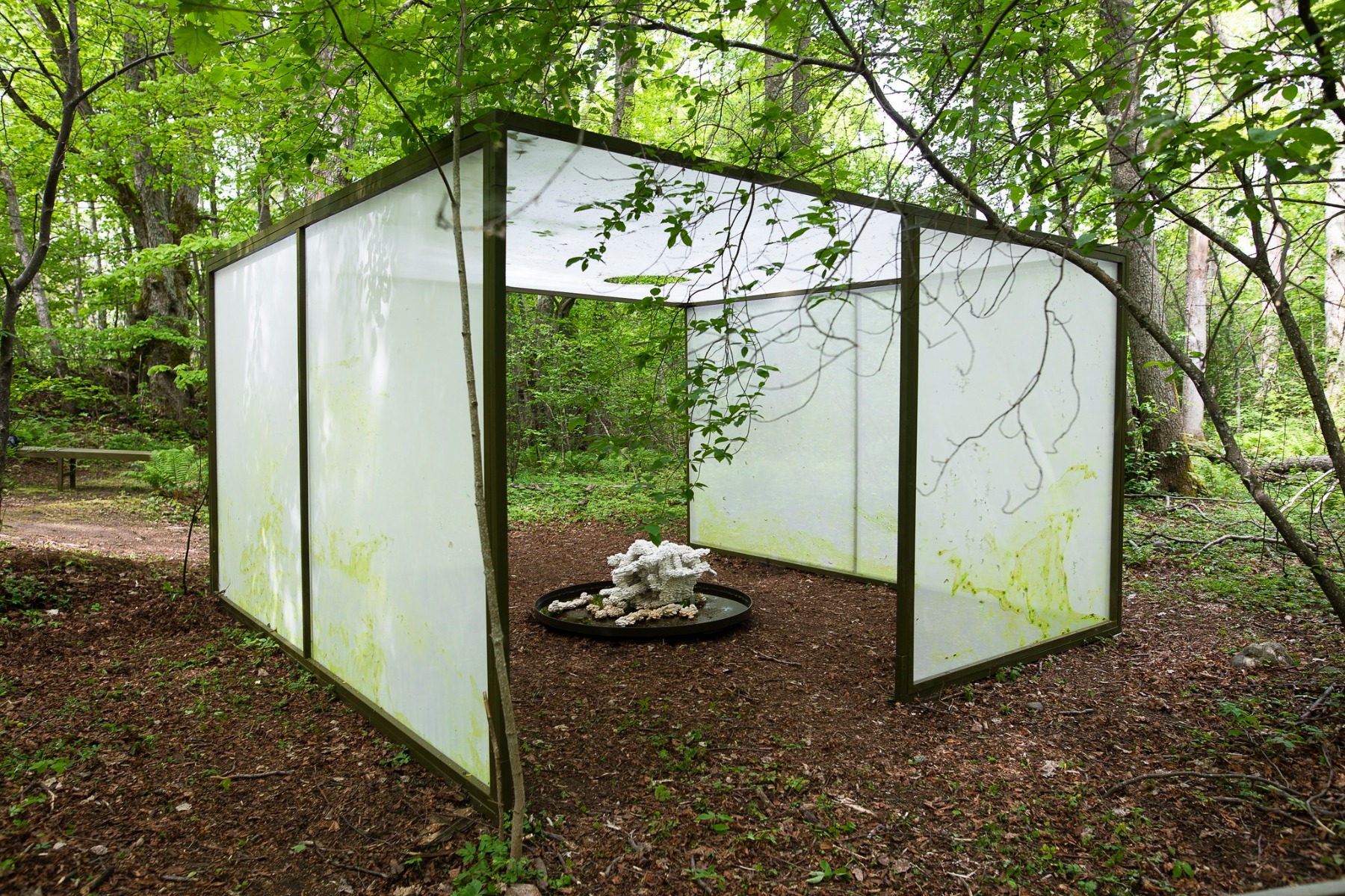
By transporting speculative and futuristic biennial projects to an abandoned island endowed with idyllic landscapes, a profound schism between nature and civilization is further accentuated. It triggers an idealization of reality rather than a critical comprehension of it. This approach turns the biennial into an enclave resembling a portal to an alternate dimension where nature prevails over humanity. The allure of “island” narratives, often entwined with utopian visions and fantastical worlds, has persisted throughout history and dates back to antiquity with Diodorus Siculus and his reimagining of “geographical” utopias such as Euhemerus’s Panchaia and Iambulus’s Islands of the Sun in “The Adventures of Iambulus in the Southern Ocean”. In light of the Finnish climate and its rainy summers, Vallisaari could aptly be dubbed “Island of the Rains”, thereby evoking more of a dystopian ambiance rather than a utopian one. Separated from the social fabric, this isolation imparts a sense of closure, further removing the biennial from the broader world.
Efforts to engage in meaningful dialogue with the city’s inhabitants have been sporadic and not always fruitful. INTERPRT, a research agency focusing on environmental justice and human rights, questioned the efficacy of Nordic truth commissions in exposing and examining the colonial history of assimilation, land dispossession, and other forms of state violence inflicted upon the Sámi community. Their multimedia installation, housed at HAM and within the foyer of Helsinki Central Library Oodi, presented a multifaceted report replete with infographics, cartographic evidence, architectural and spatial methodologies, field research, interviews, and various primary and secondary sources. Meanwhile, “Newly Formed”, a project by South Korean web artist and designer Yehwan Song, took the form of an online platform merging the collection of the Helsinki Art Museum HAM with multimodal machine learning technology. It beckoned users to explore an online city map that enabled interactions with the public art collection based on geolocations, thereby offering fresh perspectives on urban reality. Yet, in our quest for exploration, should we not also cherish the tactile and serendipitous experiences of discovering a city’s hidden nooks and crannies without reliance on websites and smartphones?
INTERPRT: Colonial Present: Counter-mapping the Truth and Reconciliation Commissions in Sápmi,2023. © HAM/Helsinki Biennial/Sonja Hyytiäinen
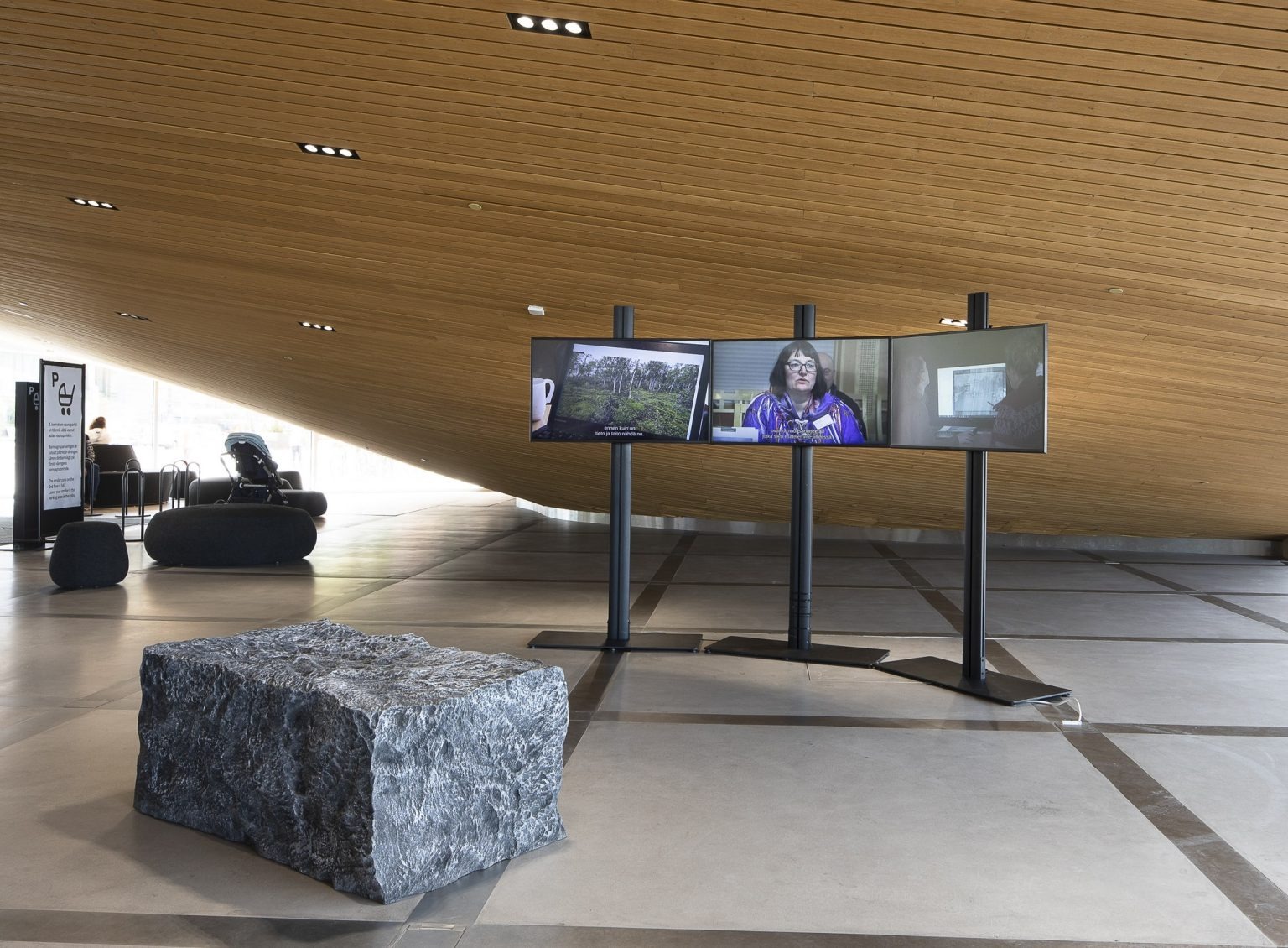
A rare exception to this digital trend was Zheng Mahler’s “Soilspace”, a vinyl mesh suspended on a wall lining a thoroughfare in Helsinki dedicated to cyclists and pedestrians. This artwork delved into global trade, the interconnected web linking nature and technology, and the intricate web of more-than-human geographies. This eye-catching billboard displayed vivid computer-generated imagery of subterranean microorganisms and mythical earth-dwelling creatures, igniting contemplation about cities built upon graves and burial sites as part of broader “soil communities”. It bore the semblance of an alternative world advertisement, functioning as a form of ancestor worship dedicated to the countless spirits residing in the soil, shaping the spaces we inhabit. While such flashy billboards represent a direct and unapologetic method to capture the attention of the public, they are not the sole means by which public art can prompt a wider audience to reflect deeply on ecological and sustainable development issues, i.e., themes at the forefront of the biennial.
It’s worth recalling that the Finnish government has set ambitious goals to achieve carbon neutrality by 2035 and carbon negativity by 2040. The biennial introduces three pivotal conceptual threads: contamination, regeneration, and agency. The Baltic Sea, considered one of the most polluted waters globally, bears the scars of unchecked industrialism and violent regimes. These issues demand vocal recognition, not timid whispers. The quest for answers on how pollution can be harnessed as a catalyst for positive change, and how the biennial can serve as a catalyst for broader renewal, has emerged as a central theme of the curatorial intent. One may also wonder if the biennial’s desire to minimize its impact on the island’s ecosystem, leaving no trace behind and reducing not only the carbon footprint but also visual pollution, aligns with the imperative to protect and preserve the island’s familiar landscape.
Zheng Mahler: Soilspace, 2023. © HAM/Helsinki Biennial/Sonja Hyytiäinen
The predominant undertone of the biennial lies in the tension between the digital realm and the tangible, in-real-life experience. It appears as though the curator, in a bid to create a striking contrast with the resplendent natural surroundings, may have initially contemplated surrendering the physical essence of the biennial to the digital domain, thereby relinquishing the intricate interplay of context, sensory stimuli, and tactile engagement that defines the physical art world. The journey, carefully structured to unfurl through multimodal acts of observation, sensory perception, and meaning-making, encouraged the audience to traverse a spectrum ranging from the minutiae of data up to the expansive realms of islands and speculative new worlds. The biennial beckoned viewers to ponder how recognizing inconspicuous or otherwise unseen details might spark opportunities for transformative action, engender alternative perspectives, and address the consequences of human interference, environmental degradation, and technological disruption.
However, it appears that even though artists posed profound questions through their works, such as critically deconstructing national identity or reimagining the role of forestry in Finland’s nation-building project, these inquiries remained relegated to the realm of the unseen, often confined to online or augmented reality. An illustrative case is the collaborative work “Green Gold” (2023) by Helsinki-based artists Ahmed Al-Nawas and Minna Henriksson, which explored these topics through an augmented reality installation. In this piece, a boat tows a massive timber raft towards the Kustaanmiekka channel, nestled between Vallisaari and Suomenlinna islands. Beyond raising pertinent queries about Finnish forestry policy, the work’s physical location ties it to the geopolitical, economic, and logistical dynamics involved in transporting raw materials through channels like Suez, Gibraltar, Bosphorus, and the Saimaa channel, which is shared by Finland and Russia. The decision to employ augmented reality may have stemmed from an inherent reluctance to express such views openly, perhaps driven by apprehension about initiating public discourse.
In a peculiar twist, the sonic artwork “On the Loss of Energy”, realized by the Red Forest collective and a research constellation led by Oleksiy Radynski, David Muñoz-Alcántara, Diana McCarty, and Mijke van der Drift, was conspicuously removed from the island’s forest and relocated to a pier in Helsinki’s harbor, the departure point for ferries to Vallisaari. This name, inspired by the aftermath of a research visit to the Chornobyl Nuclear Power Station in 2021, alludes to the forest’s transformation in response to the ecological catastrophe at Chornobyl, turning green trees red and the living into the seemingly nonliving. The project delved into the environment’s multi-scaled responses, including the atomic, emphasizing the intricate interconnectedness and resilience. It served as a reminder of our responsibility to confront the myriad layers of life in our surroundings, irrespective of the circumstances. The constellation of Red Forest spans a diverse array of disciplines, spanning media theory, philosophy, anti-colonial praxis, queer theory, feminism, and contemporary critical theory, while their practices encompass architecture, radio, film, and performance. Their project amalgamated documentary research, speculative history, musical improvisation, and science fiction to delve into the pivotal role of infrastructure in contemporary hybrid warfare scenarios. By speculating on energy dynamics amid the backdrop of war, this research infiltrated discussions around fossil-based authoritarianism, environmental injustice, and financial colonialism.
Conversely, Dineo Seshee Bopape’s sculpture “I Re-member Mama”, installed on the same pier, conveyed a more intimate level of remembrance. Crafted from soil and clay, it invited reflection on the narratives of the artist’s grandmother, and it symbolized a call for healing. This work emphasized the significance of recalling the land’s memory and the potential for restorative acts to safeguard the natural environment and its sanctity. However, it must be acknowledged that, aesthetically, the piece seemed to blend into its surroundings, resembling a nondescript fragment from a demolished structure rather than a memorable monument destined to leave an enduring imprint in the viewers’ minds. Admittedly, this approach was not the most effective means of attracting visitors, especially when placed at the iconic departure point for the ferry to the island. It is worth noting that the artist’s solo exhibition, “ka) pheko ye – the dream to come”, at the Kiasma Museum in Helsinki following the conclusion of the biennial, allowed her visual language to truly flourish.
Dineo Seshee Bopape: I Re-member Mama, 2023. © HAM/Helsinki Biennial/Sonja Hyytiäinen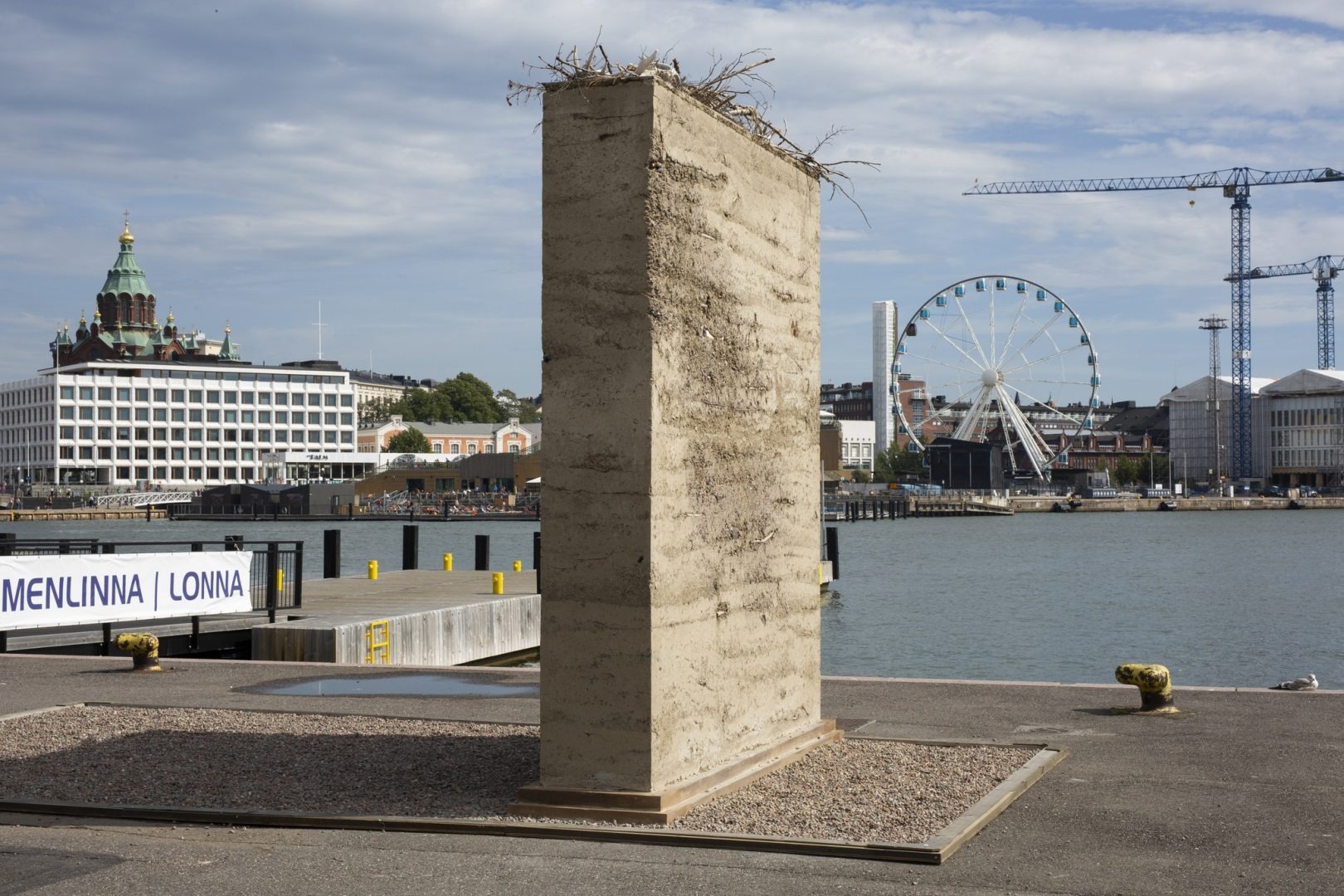
The trajectory of the two editions of the Helsinki biennial appears to mirror the narrative strategies employed by William Gibson, the trailblazing figure in the realm of cyberpunk literature and the visionary behind the concept of virtual reality. In his novel “Pattern Recognition”, Gibson executed an extraordinary narrative somersault, a move perhaps inexplicable for a science fiction author: he transposed the setting of his narrative to the present day, without any prior announcement. The revelation that the strange and enigmatic reality described in his novel was, in fact, an uncanny reflection of the world outside one’s window jolted readers. This audacious narrative maneuver aligns seamlessly with Gibson’s thematic explorations, which have long anticipated and mirrored the peculiar dynamics of the contemporary world. In a world marked by a deluge of information, an ever-growing fixation on intricate technological minutiae, and a subtle but pervasive sense of paranoia, Gibson’s recurring themes have become quotidian for many. The inaugural Helsinki biennial similarly delivered a revelation by opening up Vallisaari to the public and championing a pioneering commitment to zero carbon footprint. It underscored the harmonious coexistence of art with nature, much like the narratives envisioned by Gibson in his pioneering works.
Matti Aikio, Oikos, 2023, Helsinki Biennial 12.6.-17.9.2023, Vallisaari, Helsinki, Photo: © HAM/Helsinki Biennial/Kirsi Halkola
In his subsequent novel, “Spook Country”, Gibson adopted a similar narrative approach, although it lacked the striking impact of recognition that characterized his earlier work. Notably, the author incorporated an artist who crafts virtual monuments imperceptible to the naked eye, while introducing the concept of “locative art”—a neologism coined by the writer—into the narrative as one of its central themes. In the book, freelance journalist Hollis Henry, working on a piece about the emerging digital art movement for the European magazine Node, specialized in exploring the integration of new technologies into everyday life, akin to Wired, where Gibson himself occasionally contributed. “Locative art” revolves around virtually reconstructed historical events that are superimposed onto actual geographic locations. These installations are accessible through portable digital devices that grant entry into cyberspace. Hollis engages with one of the artists, who not only acquaints her with his work but also introduces her to a pivotal figure in this realm of art, geohacker Bobby Chombo. In “Spook Country”, there are no neon-drenched metropolises, no tales of survival at gunpoint, and no stories of seizing a lone opportunity to escape adversity. The narrative unfolds in our current world, where people lead relatively ordinary lives, and corporate conflicts tend to revolve around marketing battles rather than armed confrontations. “Locative art” is not as distant a prospect as it might appear; the requisite technologies, such as GPS and Wi-Fi, have long been deployed and tested. The Helsinki biennial’s second edition, like many hybrid phygital projects, did not always resonate with its audience, and the weariness associated with the digital experience speaks volumes about the state of our contemporary world, transcending the impact of the art projects presented at the biennial.
This peculiar attempt to gamify the biennial experience in Helsinki, and similar efforts in other contexts where art demands a degree of effort to be discovered, prompt reflection. In recent years, the media have increasingly discussed “Europecore”, the latest web aesthetic phenomenon that caters to Americans’ yearning for a taste of international summer escapism. It entails donning whimsical attire, and scenarios like reading “A Certain Hunger” in front of the Eiffel Tower epitomize Instagrammable content. Europecore is also evident on TikTok, where influencers strive to recreate “living an Italian summer in Virginia” by simply turning off their air conditioning. This trend transcends fashion; it encapsulates an endeavor to capture through the lens of a smartphone the quintessential European imagery, locations, and lifestyle attributes one anticipates in Europe. While romanticizing life in Europe is far from new, in a global scenario marked by crises and socio-political turbulence, Europe has come to represent not just a continent but a state of mind—an oasis for living life at a slower pace.
The question arises: Have biennials evolved into standardized events where predictability is the norm? Perhaps it will be not surprising to witness the emergence of a “biennialcore” trend in which collectors, art professionals, and art enthusiasts traversing continents anticipate a consistent level of comfort, accessibility to artistic expressions, and well-orchestrated mediation. To avoid a crisis of the genre and megaprojects, biennials must constantly reinvent themselves and be sensitive to the local context and audience. However, it is evident that people do not journey to Finland or embark on a pilgrimage to a remote island to indulge in extended smartphone use. The experience they seek transcends digital escapism and necessitates a deeper engagement with the physical and artistic world.
Ahmed Al-Nawas & Minna Henriksson: Green Gold. © HAM/Helsinki Biennial/Sonja Hyytiäinen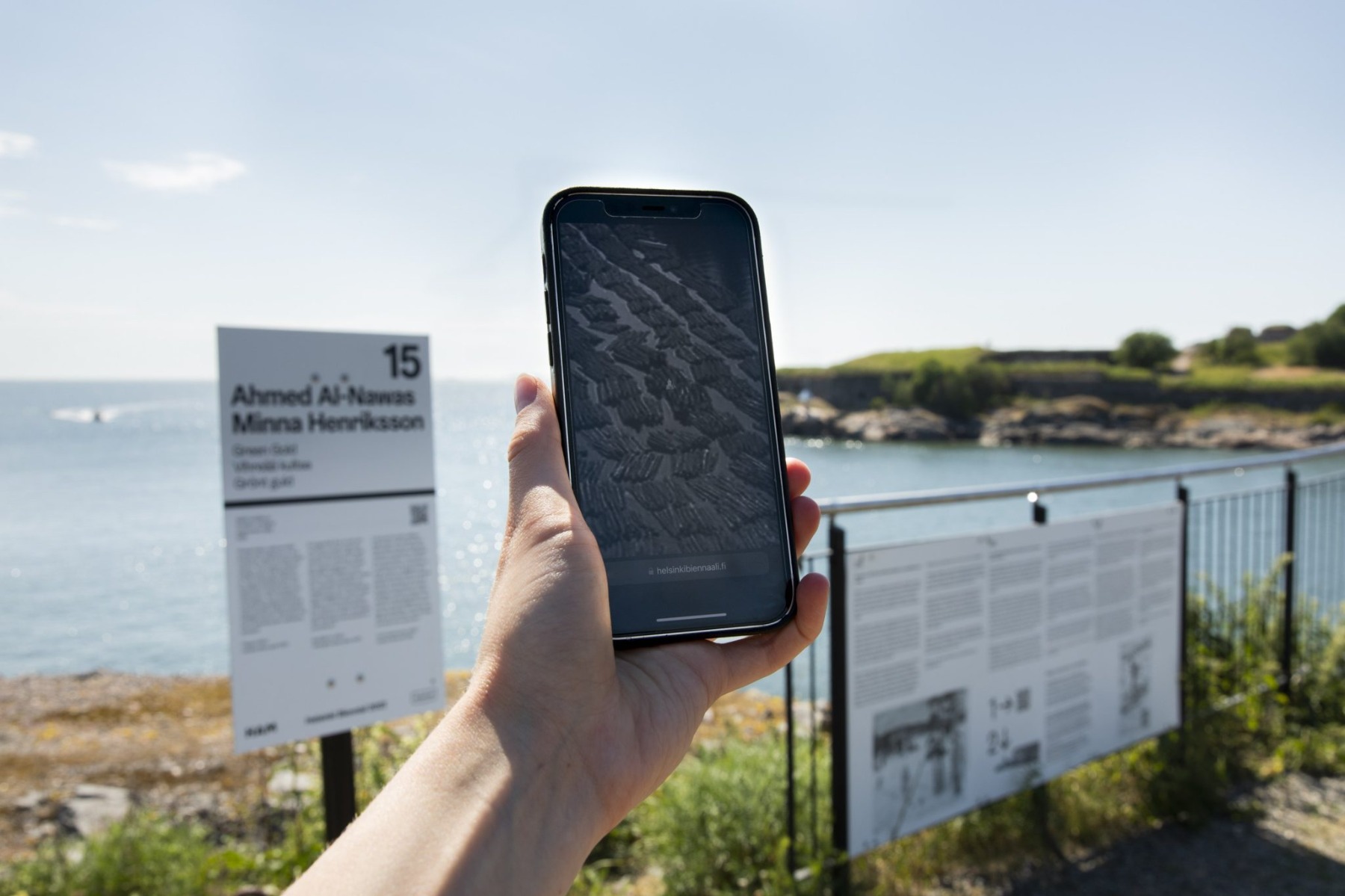
Yehwan Song, Newly Formed, 2023
Red Forest, On the Loss of Energy. Radiogram from the remnants of collisions. 2023. © HAM/Helsinki Biennial/Sonja Hyytiäinen
